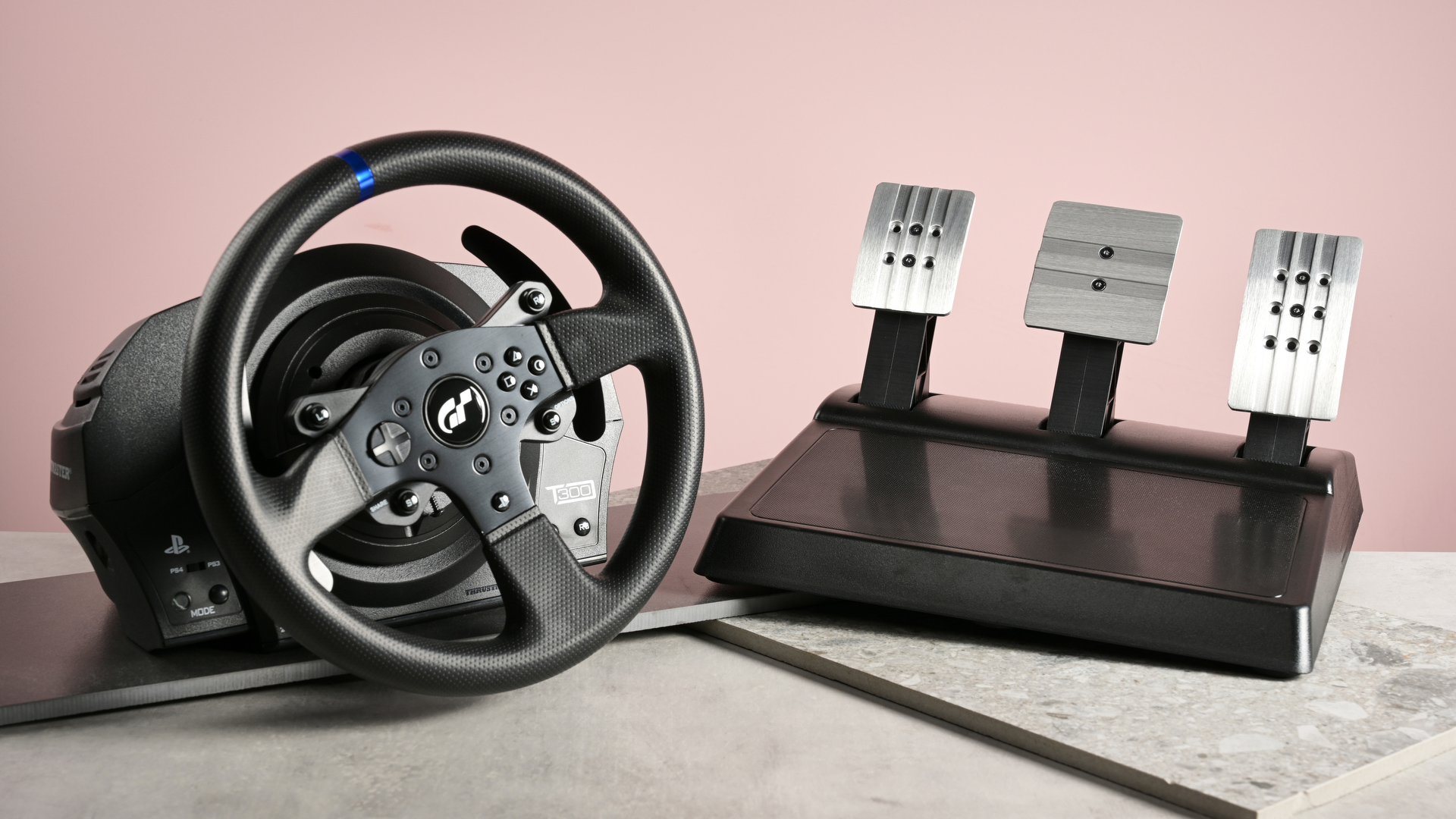
Thrustmaster T300RS GT Edition: One-minute review
The Thrustmaster T300RS GT Edition is a belt-driven racing wheel designed for PlayStation and PC. Considering it’s a GT Edition, this isn’t the most auspicious looking racing wheel. Its rather plain design isn’t helped by the lack of color. However, the leatherette material adds a touch of class and appears to be hard-wearing.
The pedals also feel durable, and feature plenty of adjustments. However, the base can slide around on smooth flooring, so rugs and carpets are best.
Installing the wheel base on a table is somewhat of a hassle, owing to the stiff fastening screw (at least on the unit I had), requiring some lubrication to make it easier. It’s also quite heavy, which means you’ll have to hold it in place while fixing it to a table. The clamping mechanism is also quite clunky, since it’s prone to moving out of position while installing, and gets in the way of the handle on the fastening screw.
Once installed, you should watch out for the self-calibration procedure that takes place as soon as you power it on, as the wheel spins quickly and forcefully. Thankfully, this is the only form of setup when using the T300 RS GT Edition with a PS5 – as you would expect from an officially licensed PlayStation product.
Things were a little more difficult on PC, though. The software tool doesn’t feel the most modern, and it took a few restarts to run correctly and update the firmware successfully. However, it does offer the settings and tweaks you would expect of one of the best racing wheels, including numerous force feedback options.
The T300RS GT Edition performs well in certain areas, but not so well in others. The steering is precise enough, and the pedals offer enough resistance without being too hard. There’s an optional conical stop you can install behind the brake pedal to lend a different sense of feedback, but I found this limited travel too much – which I found a tad too short to begin with.
The wheel can also feel very notchy, especially at the start of rotations; most noticeable when making the slow, gradual movements you might when playing more sedate driving sims. The paddles aren’t damped well enough either, feeling a little harsh in use.
While the button selection is good for PlayStation users, it’s a shame there are no rotary knobs for typical on-the-fly racing adjustments. And on PC, some buttons failed to work in my experience, although quite where the blame lies on this front isn’t exactly clear.
All of these are disappointments for a wheel of this price. The Thrustmaster T248, for instance, is considerably cheaper, yet we think it’s the best racing wheel overall thanks to its excellent performance-to-price ratio. You can of course spend a lot more on a racing wheel, such as the Thrustmaster T-GT II, but we think this is the best premium racing wheel around, as it rivals direct drive wheels – the zenith of racing wheel technology.
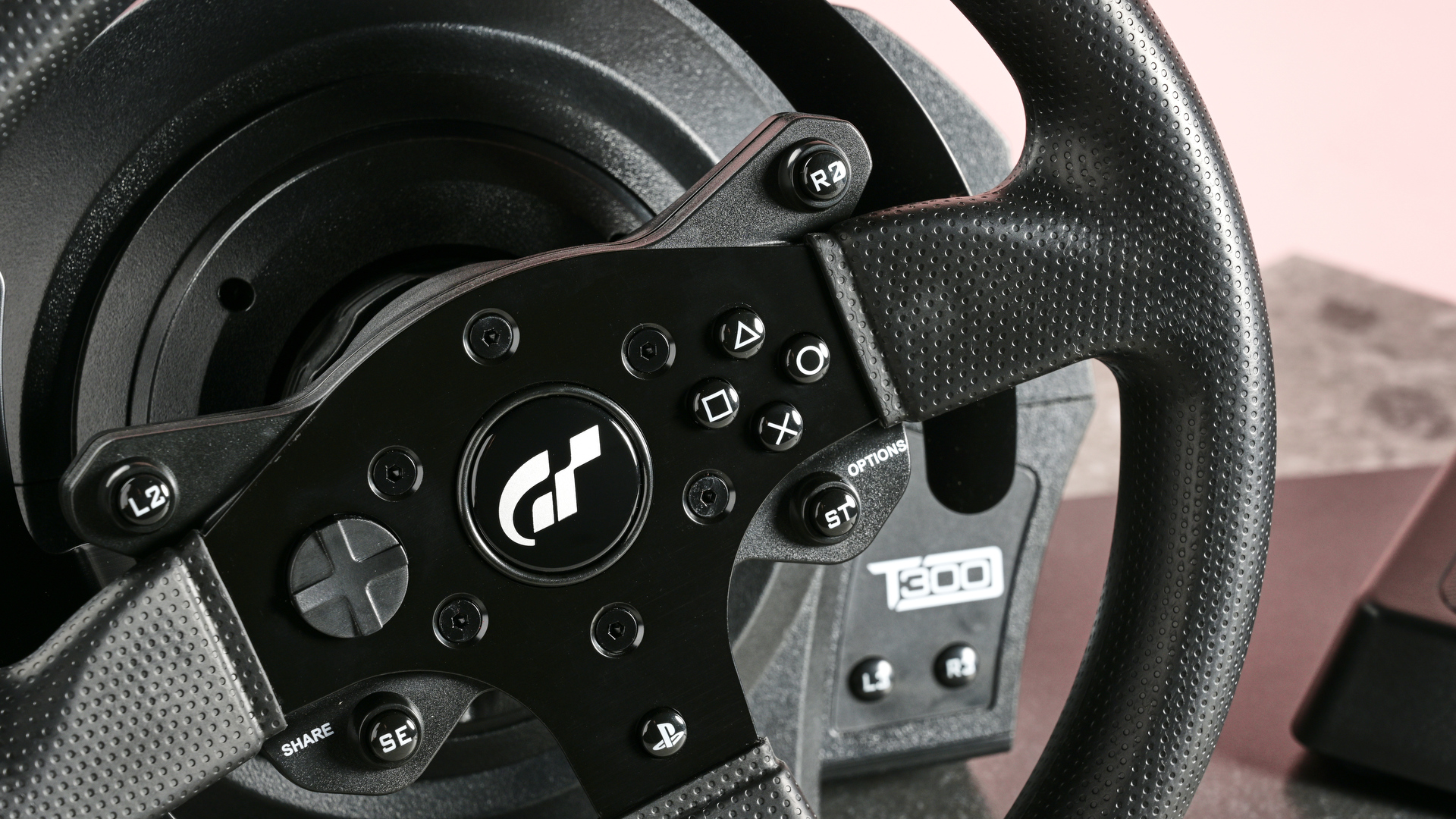
Thrustmaster T300RS GT Edition: Price and availability
- $449.99 / £379.99 (about AU$725)
- Available now in one color
- Some rivals are cheaper
The T300RS GT Edition costs $449.99 / £379.99 (about AU$725) and is available now in one colorway. It comes with a pedal set but not an external shifter, although one can be connected.
This makes it quite a lot more expensive than the Thrustmaster T248, our pick as the best racing wheel overall. This wheel offers similarly good pedals and we liked the force feedback with certain games, but again we had some issues with the steering feel.
If you want a more luxury belt-driven experience, then the Thrustmaster T-GT II is one of the best in this category, and comes close to rivaling state-of-the-art direct drive wheels. We still found the rotation wasn’t as seamless as it could be, though, and it’s considerably more expensive than the T300RS GT Edition.
Thrustmaster T300RS GT Edition: Specs
Thrustmaster T300RS GT Edition review: Design and features
- Plain looks
- Violent self-calibration
- Useful software
The T300RS GT Edition cuts a rather bland figure, with a monochromatic colorway and a lackluster wheel design that fails to inspire or excite. Considering this is the variant officially licensed by PlayStation and the Gran Turismo series, I was expecting something a little more special.
The pedals are similarly plain, although the metal heads do lend an element of sophistication. There’s also an optional conical stop, which can be screwed in behind the brake pedal to offer a different level of resistance.
The wheel has a satisfactory feel to it, being neither too thick nor too thin. The leatherette finish feels hard-wearing but offers little in the way of padding. There’s also some perforation to help with grip, and I had no issue handling it securely.
Thrustmaster doesn’t give a weight for the wheel base alone, but it’s reasonably heavy with a bias towards the front, which can make installation a little tricky. The pedal base, on the other hand, is much lighter, which can be a problem for those with low-friction flooring, as I did find it was prone to sliding unless I had a carpet or rug underneath.
Installation wasn’t the most seamless experience. The wheel attaches to the base relatively easily, requiring several turns of the Quick Release ring before tightening a small screw to secure it in place. However, attaching the base to a table is more awkward. The fastening screw in the unit I had didn’t thread smoothly, requiring some lubrication to get it working correctly.
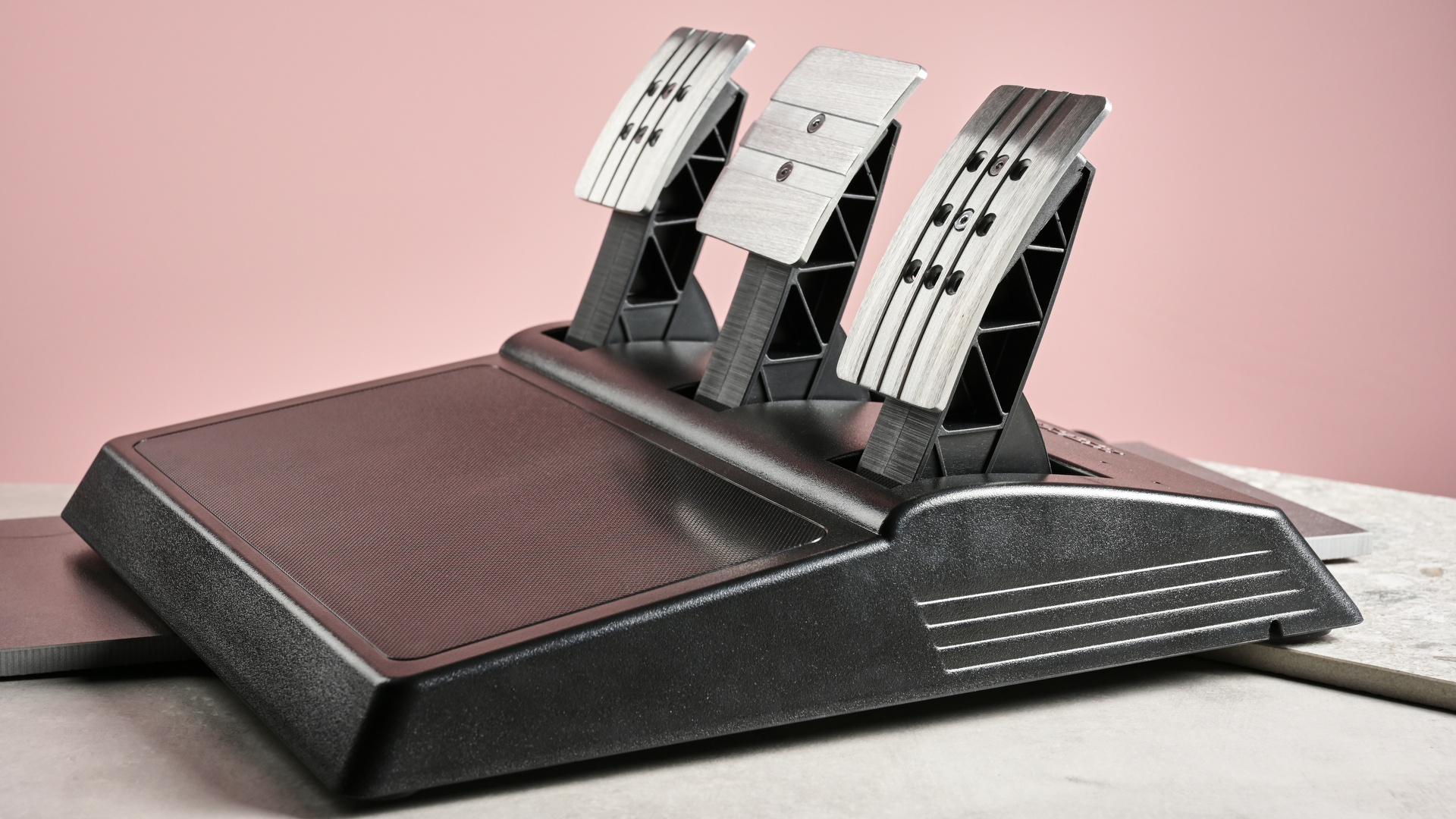
You have to hold the wheel up while you attach it, as it will fall forwards otherwise. This means tightening the fastening screw one-handed, or using your chest to prop it up while you turn it with both hands, which is the method I preferred. The handle for turning the screw kept getting in the way of the attachment system used to clamp the base to the table, which is an annoying design flaw. What’s more, this attachment system is prone to rotating out of position whilst fastening – another irksome fault.
The pedals do have a pleasing number of adjustments, made easily using the included Allen key. You can adjust the height, angle, and spacing, although I would’ve liked a wider range for the latter, as I found my legs were always too close together, but this could be a personal gripe not shared by others.
The self-calibration for the wheel begins as soon as the T300RS GT Edition is powered on and plugged in, and it took me by surprise: it’s sudden and quite forceful, so make sure to keep your hands completely clear of the wheel.
In order to adjust various calibration and force feedback settings, the Thrustmaster Control Panel for Windows is required. This failed to install on first try for me, although a couple of restarts seemed to fix the issue. The same was true of a required firmware update, but this was successful in the end.
Once up and running, the Thrustmaster Control Panel offers many of the usual customization options you’d expect of a racing wheel. You can set the maximum rotation angle and make multiple force feedback adjustments, with static settings for the constant and periodic forces, as well as dynamic ones for the spring and damper effects. All these are easy to make thanks to the basic layout of the UI.
I had no problem connecting the T300RS GT Edition to a PS5, making it as easy to use as the best PS5 racing wheels out there. The button layout on the wheel is also similar to a controller, which makes navigation simple. It’s a shame, however, that there are no rotary dials, useful for adjusting common racing settings such as traction control and brake balance.
Thrustmaster T300RS GT Edition review: Performance
- Balanced pedal feel
- Notchy steering
- Overly strong force feedback
The T300RS GT Edition offers a mixed performance. The steering feels accurate and precise, although the paddles were too clicky for my liking, lacking the satisfying action better damped switches offer.
The pedals provide enough resistance to let you feel how your inputs translate in-game, yet light enough to make them easy to press without fatigue. The clutch pedal offers just the right amount of travel; while I would’ve preferred a bit more for the brake pedal, it still offers enough control. It’s also reassuringly weighted, although I found the optional conical stop added too much resistance, and further decreased the already-wanting travel.
However, my chief grip with the T300RS GT Edition is the notchy feel of the steering wheel. No matter what you do with the settings in the Control Panel, this is always present. I found it particularly noticeable when making small movements close to the center of the axis, which you are likely to do in slower-paced driving sims, as opposed to outright racing sims.
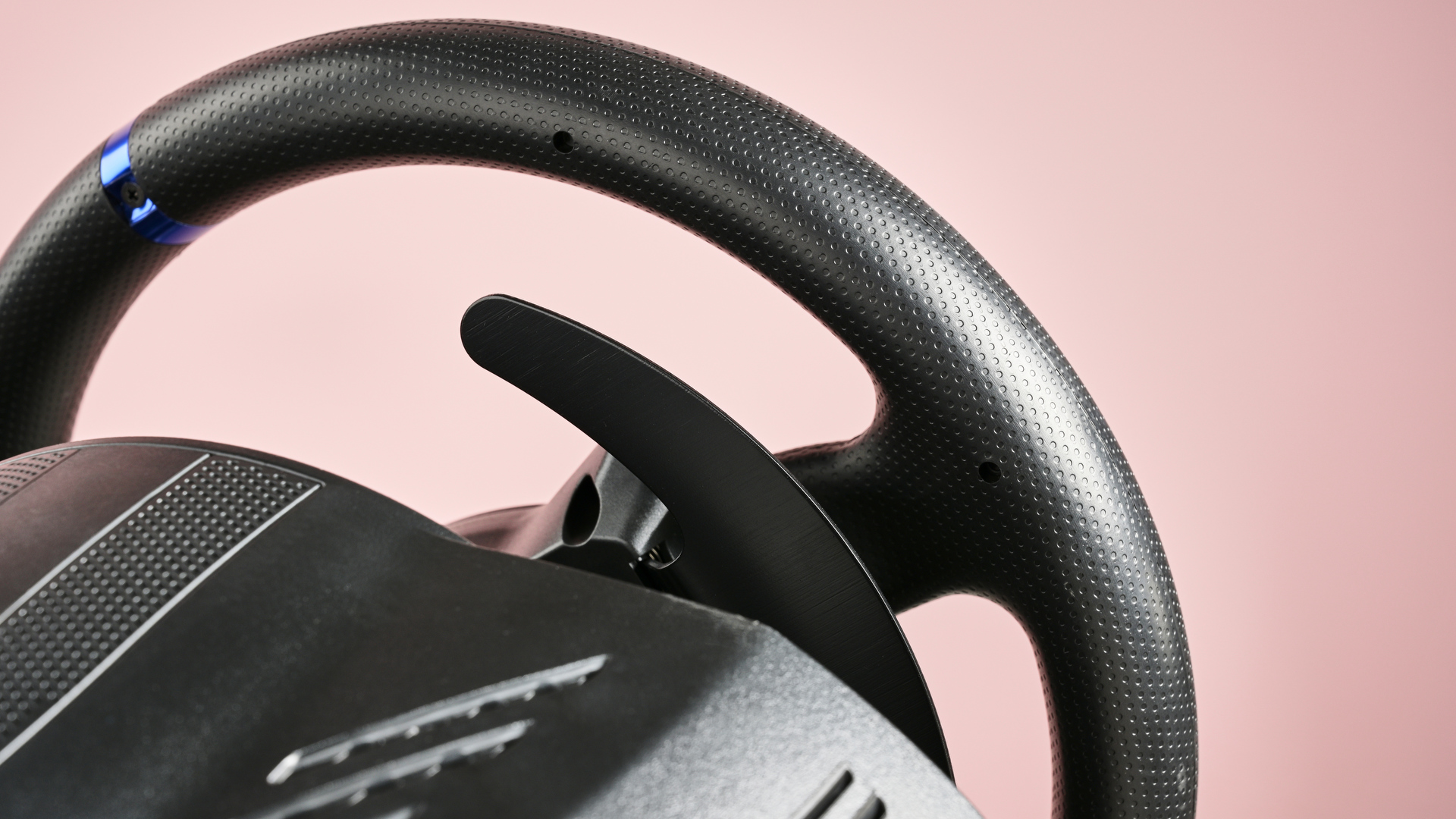
The other settings available in the Control Panel do make a difference to performance. There’s plenty of scope within the force feedback for most gamers to find the right setup. The maximum setting was far too strong for me, with the wheel being too hard to turn and flailing wildly when losing traction in-game. As a result, I preferred having the overall strength setting quite low, at about 15%.
The buttons on the wheel all perform well enough, but don’t match the premium feel of those on the best PC controllers. I did have an issue with the POV hat failing to work with some PC games, but this could’ve been a fault with the game rather than with the input itself.
Should I buy the Thrustmaster T300RS GT Edition?
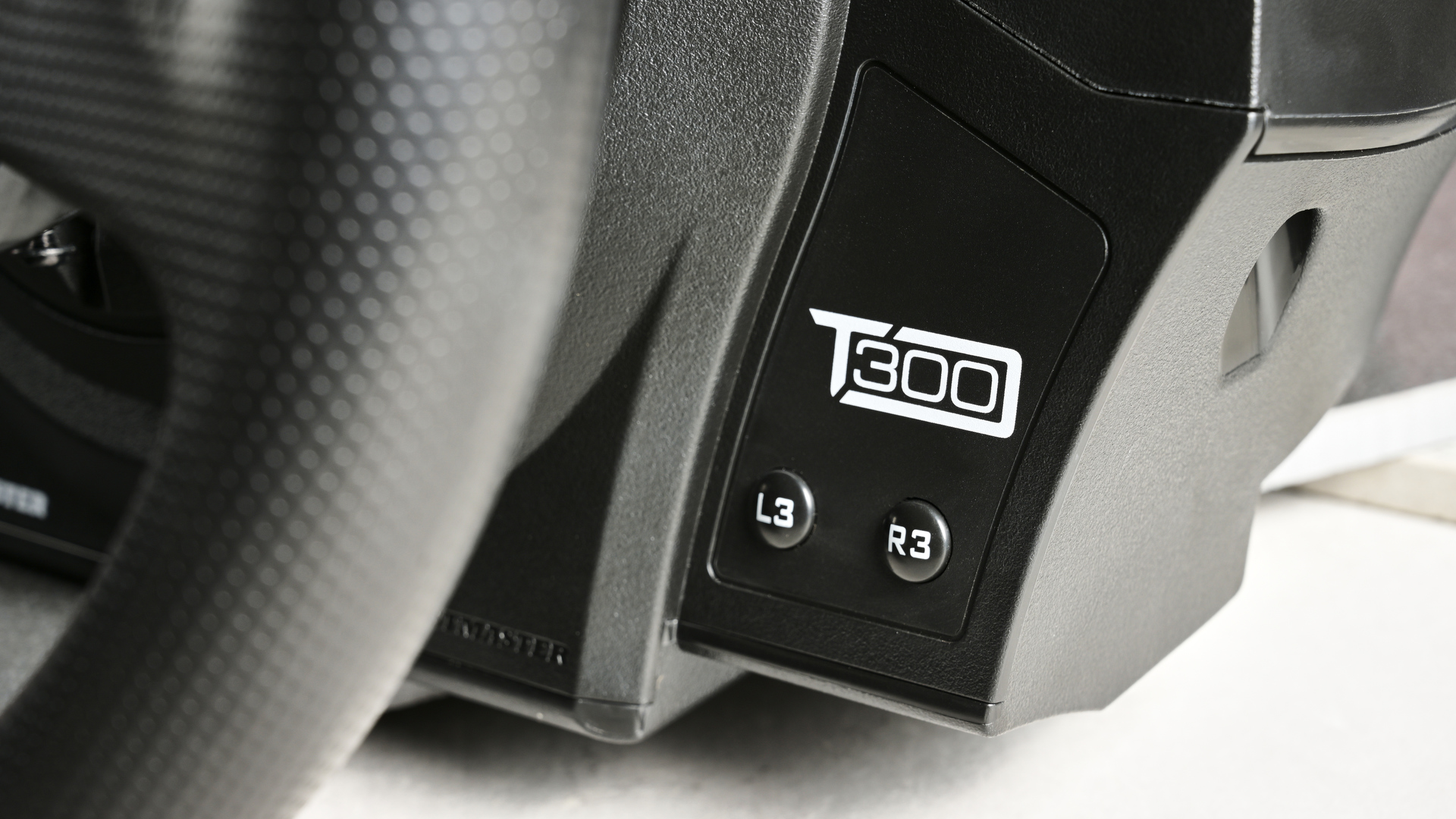
Buy it if...
Don't buy it if...
Also consider...
If the T300RS GT Edition doesn't sound right for you, then take a look at these excellent alternatives.
How I tested the Thrustmaster T300RS GT Edition
- Tested for one week
- Used on PC and PS5
- Plentiful racing sim experience
I tested the T300RS GT Edition for about a week, during which time I used it on PC and PS5. I installed it myself and made sure to adjust as many hardware and software settings as possible, such as pedal positioning and force feedback. Unfortunately, I wasn’t able to test the T300RS GT Edition with an external shifter.
I played Gran Turismo 7 on PS5 and Assetto Corsa on PC – two two-tier racing sims on their respective platforms. I also played American Truck Simulator to test the wheel for slower, more controlled steering and pedal movements.
I have been gaming for over 25 years, with racing sims being one of my favorite genres. I play numerous titles across various sub-categories such as F1, touring car racing, and rallying.
First reviewed January 2025







